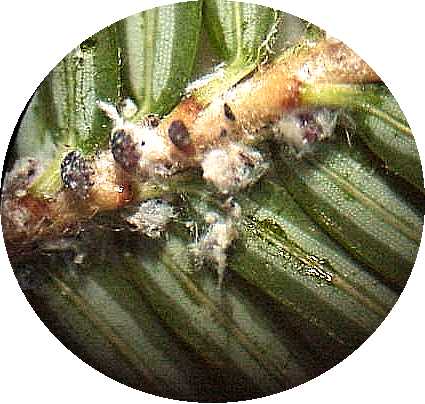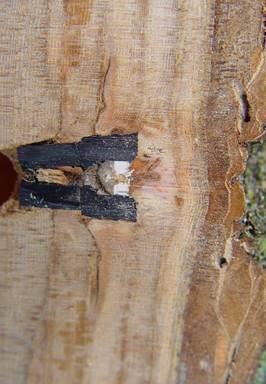If conifers are so slow to uptake from a liquid application applied by tree injection (you may recall from our last exciting installment, the tree’s vascular system relies solely are microscopically and absurdly tiny tracheids), then why not just spray the tree or, better yet, drench around its base?
But wait! The method of treatment is determined by a number of factors, which include tree size, where it is growing, the pest strategy, and the chemistry you plan to apply.
Spraying or drenching may or may not be options, given the tree’s size and location. For example, mature hemlocks can easily reach heights of 100 feet or more; spraying to cover the foliage is nearly impossible even with high pressure spray rigs, and then of course there is an issue of off-target drift. So one needs to take into account the height of the tree intended for treatment.
One can drench with a systemic around the base of the tree to reach the very top of the tree. That may be an option for hemlocks infested with hemlock woolly adelgid (HWA), but not if that tree is growing near water, as many do.
Often we are faced with infested trees growing in wet areas and in areas near stream banks, zones that precluded foliar sprays and drench applications. So environment plays a role in choosing and planning your approach to treatment.
Pines and spruces are sometimes attacked by bark beetles. The standard treatment with a high pressure spray rig is bole sprays of carbaryl or bifenthrin. Effective systemic insecticides cannot be applied as drenches for these pests, and trees are not always accessible by spray rig (think of woodland trees). So chemistry plays a role in determination of the application method.
If the site of infestation (by an insect, an example, mountain pine beetle) or infection (by a micro-organism, for example, blue-stain fungus) is under the bark, topical applications would not necessarily be an application of choice. So the pests’ pattern of attack plays a role in your choice of method.
Conifers can be treated by tree injection. Hemlock, pine, spruce, and fir trees all can be treated. Here, we will discuss treating hemlock trees for hemlock woolly adelgid.

Adelgids are very small, piercing-sucking, aphid-like insects which feed on conifers. The hemlock woolly adelgid (HWA) damages the tree by siphoning sugars, which results in reduced tip growth, which gradually progresses until the infested limb dies. Untreated, HWA can ultimately kill a tree. Hemlock woolly adelgid infestation is characterized by the telltale whitish woolly masses on the twigs at the bases of the needles.
HWA has a complex life cycle with two generations (progrediens and sistens) per year. It undergoes a period of summer aestivation (resting stage) as a first instar nymph, after which it completes it lifecycle through the winter (sistens generation) protected by a thick woolly “coat”. It develops through 4 nymphal stages before becoming adults in March (in the northeast). The adults, all female, produce eggs which hatch into (progrediens generation) crawlers in spring (April), and progress through 4 additional nymphal stages, becoming adults which lay eggs by June.
HWA actively feeds through the fall, winter and spring. Fall and spring are ideal times to treat hemlock. Published documentation supports the use of IMA-jet® (5% imidacloprid) to control HWA infestations. Though imidacloprid, in general, may be applied as a soil drench, we recommend tree injection as a treatment, especially in trees that grow in riparian zones (wetlands) and in areas where flowering (understory) plants may take up the active ingredient if drenched.
To inject trees using the Arborjet methodology, drill into the trunk flare tissue into the sapwood. Install the Arborplug® which creates the injection port. The Arborplug is designed with an internal, self-closing septum to prevent backflow during the process of injection. Always read the IMA-jet label before applying the treatment to the tree, and follow the guidelines for personal protective equipment (PPE).
We have studied the longevity of tree protection in hemlock following injection with IMA-jet and have found that a treatment can protect a hemlock for at least 2 years. When injecting the active ingredient, it is not subject to photolysis (which is the breakdown in response to light) and hence its longevity of activity. Furthermore, in evergreen conifers which retain their needles for multiple years, the active is retained as well. In hemlock, leaf retention may be from 3 to 6 years!
It is not unusual for soil injection or drench applications to spec 10 times the amount of active ingredient at application compared to tree injection; therefore per acre label restrictions limit the number of trees that can be treated. There is no such restriction for tree injection as the active ingredient is applied directly into the trees vascular system. An added value of tree injection therefore, is a judicious and reduced use of pesticide!
Next time…how would you treat forested areas using tree injection?
Stay tuned for more…
Joe Doccola
Director of Research and Development at Arborjet, Inc.
